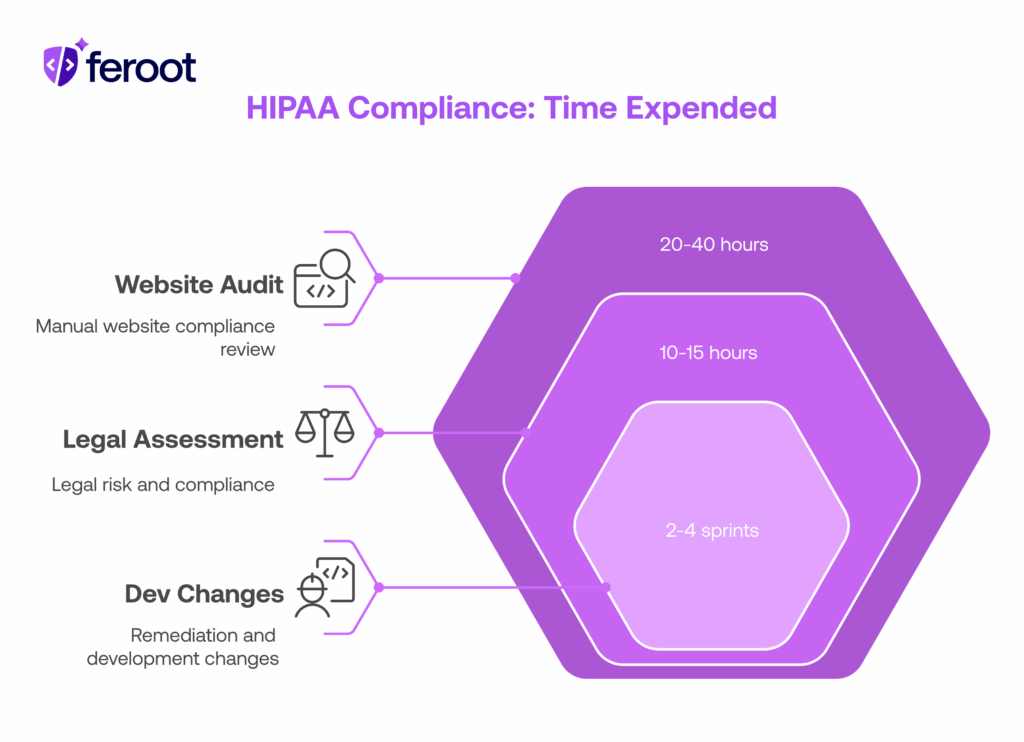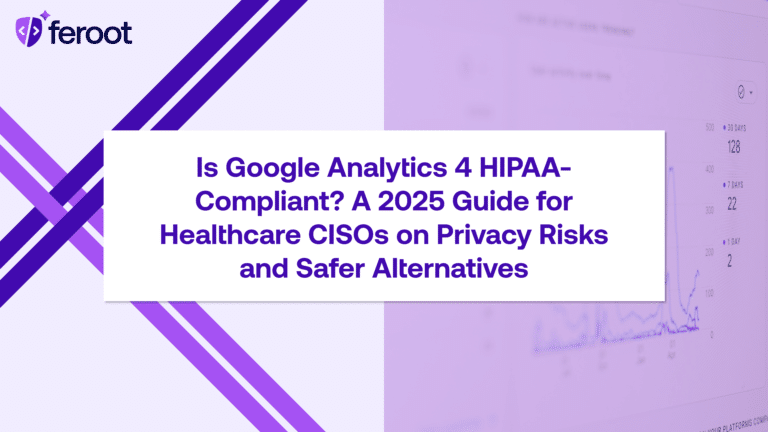TL;DR
- HIPAA violations tied to online tracking are rising—HHS guidance now targets tools like Meta Pixel and Google Analytics.
- Many low-cost solutions fail to catch client-side risk or meet regulatory expectations.
- Manual audits cost time and money—Feroot automates visibility and compliance on the browser side.
- Feroot’s HealthData Shield AI protects PHI from unauthorized collection and helps security teams pass HIPAA audits affordably.
Why Is HIPAA Suddenly Focused on Online Tracking?
The U.S. Department of Health and Human Services (HHS) clarified in 2022 and again in 2023 that tracking technologies like Meta Pixel and GA4 can expose Protected Health Information (PHI). This applies even if PHI isn’t explicitly shared—contextual data such as appointment searches or logged-in status on a patient portal can qualify.
Key updates:
- Covered entities and business associates must ensure tracking tools don’t leak PHI without patient authorization.
- IP addresses, UTM parameters, and cookies tied to health activity may now trigger HIPAA compliance obligations.
- Many common marketing and analytics platforms do not offer Business Associate Agreements (BAAs), making them high-risk.
What Makes HIPAA Tracking Compliance So Costly?
Compliance costs spike when organizations rely on manual reviews or reactive audits. Many teams:
- Review only server-side logs, missing browser activity
- Lack tools that show which scripts access PHI
- Pay consultants or legal teams to audit marketing tech
Real costs add up fast:
| Compliance task | Time expended |
| Manual website audit | 20–40 hours |
| Legal risk assessment | 10–15 hours |
| Remediation and dev changes | 2–4 sprints |

Which Tracking Technologies Create the Most HIPAA Risk?
High-risk tools commonly flagged in enforcement and guidance:
- Meta Pixel (used on patient portals, appointment pages)
- Google Analytics / GA4 (tracks behavior, URLs, referrers)
- Hotjar, Crazy Egg (session replay, keystroke logging)
- Advertising pixels (LinkedIn, TikTok, etc.)
Red flags:
- No Business Associate Agreement (BAA)
- Access to PHI without user authorization
- Operating on login-protected or sensitive health pages
Why Do Most Tools Fail to Detect HIPAA Violations?
Most compliance and analytics tools miss browser-side risk because they:
- Monitor only network or server logs
- Don’t inspect dynamic JavaScript execution
- Ignore how third-party scripts collect and transmit data in real time
This creates “invisible violations” where unauthorized tracking happens:
- After login
- During form fills
- On secure appointment confirmation pages
Result: You think you’re compliant—but you’re leaking data.
What Happens If We Ignore HIPAA’s Online Tracking Rules?
The risks of noncompliance with HIPAA’s tracking guidance go beyond reputational damage. Regulators have already started enforcing penalties against healthcare providers and digital health platforms that expose PHI through tracking tools.
What’s at stake:
- Civil penalties: HHS can impose fines up to $50,000 per violation, even without patient harm.
- FTC enforcement: The FTC has pursued cases under the Health Breach Notification Rule for improper data sharing via tracking pixels.
- Reputational fallout: Lawsuits and media coverage have followed several high-profile enforcement actions.
- Legal scrutiny: Using tools like GA4 or Meta Pixel without a BAA—even unknowingly—can trigger audits and class action risk.
How Does Feroot Help Lower the Cost of HIPAA Compliance?
Feroot protects client-side data exposure by monitoring browser behavior—not just logs. It’s designed to help healthcare and healthtech companies comply with HIPAA’s online tracking requirements without breaking the bank.
What Feroot does:
- Scans all front-end code (scripts, cookies, pixels)
- Flags unauthorized tracking tied to PHI
- Maps findings to HIPAA guidance automatically
- Delivers audit-ready reports for legal and security review
Unlike traditional compliance tools:
- Covers what’s actually rendered in the browser
- No code changes or re-architecture needed
- Continuous monitoring and alerting—no manual audits
- Works across staging and production environments
What Results Have Healthtech Security Teams Achieved?
Teams using Feroot have eliminated costly manual audits, avoided regulatory scrutiny, and cut HIPAA compliance prep from months to days.
Real-world outcomes:
“Feroot helped our team gain outside-in visibility into the security of customer experience making our platform even more secure.” – Ralph Pyne, Sr. Director, Information Security at Adroll
“Automating our HIPAA compliance saved our privacy team countless hours. Now we have complete visibility and control over PHI access.” – Privacy Director, Leading Healthcare Network

How Does Feroot Help CISOs Automate Compliance and Reduce Risk?
Feroot streamlines compliance with regulations like HIPAA by offering full visibility into the client-side of your applications—where most tracking violations happen.
Why it matters:
- Traditional compliance tools miss what happens in the browser
- HIPAA fines can result from third-party scripts accessing PHI
- Security teams need a real-time way to enforce tracking boundaries
Feroot’s capabilities:
- Identifies tracking pixels on login pages, appointment flows, and patient portals
- Maps activity to HIPAA risk areas and enforcement guidance
- Blocks unauthorized access to PHI at the browser level
- Creates audit-ready exports for internal and external review
FAQ
How does compliance automation improve HIPAA audit outcomes?
Automated tools like Feroot give you real-time reports on violations, eliminate blind spots, and help you document controls proactively.
Can we manage tracking compliance across multiple domains or apps?
Yes—Feroot scans and monitors multiple sites, environments, and user flows from a centralized dashboard.
Does Feroot work with tools like Google Tag Manager?
Yes—Feroot shows what each tag or script does in the browser, including unauthorized PHI access.
What if we don’t have a compliance expert on staff?
Feroot makes HIPAA tracking compliance accessible for security teams and DevOps—not just legal.
Is this solution affordable for startups?
Yes—Feroot’s pricing model is startup-friendly and helps small teams avoid expensive audit surprises.
Conclusion
Most HIPAA online tracking compliance failures start in the browser. Feroot helps CISOs and security teams catch these violations before they become regulatory incidents—at a fraction of the cost of traditional audit prep.
Save time. Reduce legal risk. Automate your HIPAA tracking compliance.


